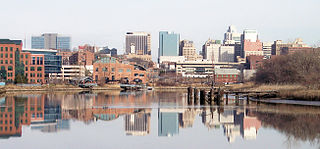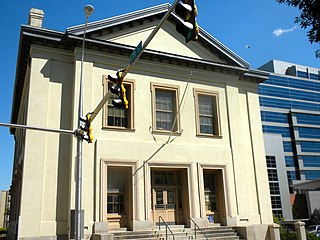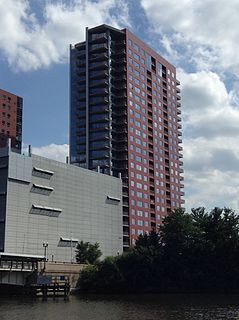
Delaware is a state in the Mid-Atlantic region of the United States, bordering Maryland to its south and west; Pennsylvania to its north; and New Jersey and the Atlantic Ocean to its east. The state takes its name from the nearby Delaware River named after Thomas West, 3rd Baron De La Warr, an English nobleman and Virginia's first colonial governor.

Dover is the capital and second-largest city of the U.S. state of Delaware. It is also the county seat of Kent County and the principal city of the Dover, DE, Metropolitan Statistical Area, which encompasses all of Kent County and is part of the Philadelphia–Wilmington–Camden, PA–NJ–DE–MD, Combined Statistical Area. It is located on the St. Jones River in the Delaware River coastal plain. It was named by William Penn for Dover in Kent, England. As of 2010, the city had a population of 36,047.

Elsmere is a town in New Castle County, Delaware, United States, bordering the city of Wilmington along Wilmington's western border. According to the 2010 Census, the population of the town is 6,131.

Newark is a city in New Castle County, Delaware, United States. It is located 12 miles (19 km) west-southwest of Wilmington. According to the 2010 Census, the population of the city is 31,454. Newark is home to the University of Delaware.

Wilmington is the largest and most populous city in the U.S. state of Delaware. The city was built on the site of Fort Christina, the first Swedish settlement in North America. It lies at the confluence of the Christina River and Brandywine River, near where the Christina flows into the Delaware River. It is the county seat of New Castle County and one of the major cities in the Delaware Valley metropolitan area. Wilmington was named by Proprietor Thomas Penn after his friend Spencer Compton, Earl of Wilmington, who was prime minister during the reign of George II of Great Britain.
E‑ZPass is an electronic toll collection system used on most tolled roads, bridges, and tunnels in the Midwestern and Eastern United States, as far south as Florida and as far west as Minnesota. The E-ZPass Interagency Group (IAG) consists of member agencies in 19 states, which use the same technology and allow travelers to use the same transponder on toll roads throughout the network. Since its creation in 1987, various independent systems that use the same technology have been folded into the E-ZPass system, including the I-Pass in Illinois and the NC Quick Pass in North Carolina. Negotiations are ongoing for nationwide interoperability in the United States.
The Delaware River and Bay Authority or DRBA is a bi-state government agency of the U.S. states of New Jersey and Delaware established by interstate compact in 1962.

The Port of Philadelphia is located on the Delaware River in Philadelphia in the U.S. state of Pennsylvania.

The Joseph R. Biden, Jr., Railroad Station, also known as Wilmington station, is a passenger rail station in Wilmington, Delaware. One of Amtrak's busiest stops, it serves nine Amtrak train routes and is part of the Northeast Corridor. It also serves SEPTA Regional Rail commuter trains on the Wilmington/Newark Line as well as DART First State local buses and Greyhound Lines intercity buses.

The Diocese of Wilmington is a Latin Church ecclesiastical territory or diocese of the Catholic Church in the eastern United States and comprises the entire state of Delaware and the Eastern Shore of Maryland. The Diocese of Wilmington is one of four Catholic dioceses in the United States to have territory in more than one federal entity; the Diocese of Gallup and the Diocese of Norwich each span two states while the Archdiocese of Washington spans Washington, D.C. and five counties of Maryland.
In United States constitutional law, a state actor is a person who is acting on behalf of a governmental body, and is therefore subject to limitations imposed on government by the United States Constitution, including the First, Fifth, and Fourteenth Amendments, which prohibit the federal and state governments from violating certain rights and freedoms.

The Delaware Legislative Hall is the state capitol building of Delaware located in the state capital city of Dover on Legislative Avenue that houses the chambers and offices of the Delaware General Assembly. It was designed in the Colonial Revival architecture style by E. William Martin and Norman M. Isham, and built 1931-1933, with wings added 1965-1970, 1994.
Louis Lorenzo Redding was a prominent lawyer and civil rights advocate from Wilmington, Delaware. Redding, the first African American to be admitted to the Delaware bar, was part of the NAACP legal team that challenged school segregation in the Brown v. Board of Education case in front of the U.S. Supreme Court. He was 96 when he died at a hospital in Lima, Pa.

The Franklin County Government Center is a government complex of Franklin County, Ohio in the city of Columbus. The government center has included several iterations of the Franklin County Courthouse, including a building completed in 1840 and another completed in 1887. Current courthouse functions are spread out between buildings in the complex.

The Old Customshouse is a historic government building at 516 North King Street in Wilmington, Delaware. It was built in 1855 and added to the National Register of Historic Places in 1974.
Lebron v. National Railroad Passenger Corporation, 513 U.S. 374 (1995), is a United States Supreme Court case in which the Court held that Amtrak is a government agency and thus is subject to the First Amendment.
Jackson v. Metropolitan Edison Co., 419 U.S. 345 (1974), is an administrative law case of the Supreme Court of the United States holding that extensive state regulation of a public utility does not transform its acts into state action that is reviewable by a federal court under the Fourteenth Amendment to the United States Constitution.

The River Tower at Christina Landing is a high rise located in Wilmington, Delaware. It is the tallest building in both the city of Wilmington and the state of Delaware, rising 25 stories with a 13th floor, and 295 ft (90m.). The Building was constructed in 2005, and opened in 2007. The tower was designed by Stantec Architecture, Inc.
The Daniel L. Herrmann Courthouse is a building in downtown Wilmington, Delaware. Built in 1916, the former courthouse is currently occupied by Young Conaway Stargatt & Taylor, a Wilmington-based law firm.












